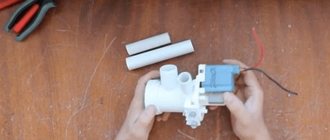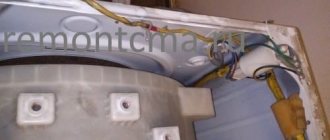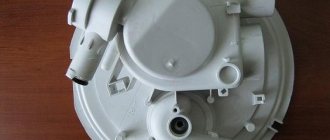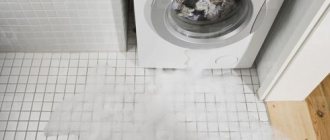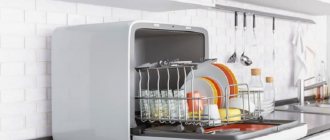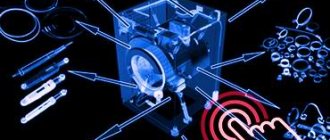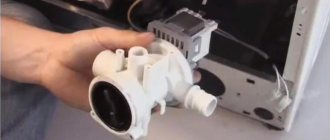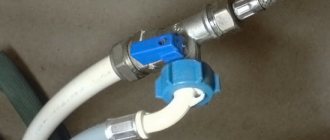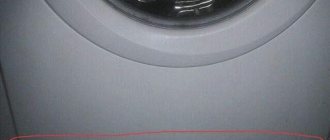Convenient and reliable automatic washing machines are successfully used in city apartments, where there is always a good pressure of cold water and a sewerage system. But rural residents and summer residents continue to use outdated models that require manual filling and draining, citing the impossibility of proper water supply with modern devices. Let's consider how to connect an automatic machine without a central water supply in order to be able to use the benefits of civilization.
In what cases is it necessary to connect a machine without running water?
Modern equipment allows even in the country to create normal conditions for the high-quality operation of any automatic washing machine. To do this, we need to remember the principle of operation of such devices.
How does a washing machine work?
An automatic washing machine (AWA) is an intelligent household appliance that can perform its duties with just three connections:
- to an AC electrical network with a voltage of 220 volts;
- to a source of clean water supplied with sufficient pressure to dissolve detergents and fill the tank with pressure;
- to the place where waste solutions are drained.
Washing machine operating diagram
All actions of the machine are controlled by a control unit that gives commands to the engine that rotates the drum, the pump that pumps out the liquid, the valves and sensors that regulate the process of filling the tank with liquid. After loading the laundry and pouring the powder into a special bath, the valve on the water supply line opens. She washes off the powder and fills the tank to a certain level. The heating element is responsible for heating it.
The processes of soaking, washing and spinning occur when the drum rotates at the required speed. During operation, water is pumped out of the machine several times, taking with it all foreign matter. As a result, the housewife takes out slightly damp, clean linen, which only needs to be dried and ironed.
For information! Some models are capable of dispensing items in a dried state without creasing.
It turns out that there are almost no problems with these connections in rural areas. Electrification is everywhere. During power surges, you can use a gasoline or diesel power generator. To drain dirty solutions, there are septic tanks or cesspools, and to supply water there are a lot of technical devices that create the necessary pressure. You just need to know how to connect your washing machine without running water.
Benefits of using SMA without running water
The operation of automatic washing machines in villages that do not have a centralized water supply can provide their owners with tangible benefits:
- You can use rainwater, which is considered the softest and purest. It allows you to wash things efficiently using a minimum of detergents. At the same time, scale does not form on the heating element, which extends its service life.
- There is no need to pay for using water from your own well or borehole, and this is a direct saving on the family budget.
- The old model, which you considered unsuitable for a city apartment, can serve in the country for many years.
If you value convenience, then you can safely bring new or used equipment to your country house, knowing exactly how to connect a modern automatic washing machine without running water.
Options for connecting an automatic machine without running water
An automatic washing machine without connection to the central pipeline can be used in various ways. Which one is right for you, decide for yourself.
Container for detergents
The simplest material method for supplying clean water to a tank is to manually pour it through a slightly open container for powder and special solutions. It does not require any technical tricks, but requires constant human participation. He will have to add water from a bucket or other container every time it is required in accordance with the selected program.
Come to think of it! In this case, the very meaning of using an automatic machine disappears. Soon the owner has a desire to purchase a simple activator-type equipment.
Container with water
The next option involves installing a small tank or container at some elevation, connecting it with a pipe or hose to the inlet pipe of the machine. It will be able to operate as usual, and the flow of water will be carried out by gravity. Despite the reasonableness of the approach, this method has significant disadvantages:
- To create a pressure sufficient to wash off the powder, you will need to raise the container to a height of about 10 meters. Agree that not every dacha has such dimensions, and building a special water tower is not the cheapest solution.
- Not every adherent of such “automation” of household work will be ready to carry about 100 liters of water needed for each wash in buckets.
Well drilling
Almost all issues with providing household appliances with cold water are resolved by a device located in a suburban area of an artesian well.
It is equipped with a pumping station that maintains operating pressure automatically. In this case, connecting a washing machine in a house without running water will not differ from a standard installation somewhere in a city apartment. This method has two disadvantages:
- The aquifer may be deep. Then drilling a well and installing a powerful pump will cost a lot of money.
- Water from a well may contain dissolved mineral salts, which will negatively affect the operation of the heating element and cause premature corrosion of the equipment.
Using the pump
If the main thing for the normal operation of an automatic machine is a stable supply of clean water with the required pressure, then even the simplest centrifugal pump, turned on during washing, will be a simple solution to the problem. To do this, it is enough to place it in a nearby drinking well or connect it to a small container installed next to the SMA. On a note! For these purposes, you can use a stationary surface or submersible pump that creates a discharge pressure of at least one atmosphere.
About existing connection options
The main condition for any option is the organization of water supply under certain pressure indicators. There are several solutions to get the result:
- Adding water manually. Water is added through the detergent compartment added to the machine. But there is also a significant drawback - the device stops every time the program ends. To continue working, you need to add water. This process can be quite labor intensive and time consuming.
- Installation of pumping stations to which you can connect a washing machine in the country. Such decisions are associated with additional financial costs. And such expenses are not always justified, especially if the dacha is used only in the summer, and only the washing machine requires connection. A source of clean water is important, but such amenities are not always available.
- Creating pressure artificially. The result can be achieved by placing the water tank significantly higher compared to the washing machine. An 8-10 meter indicator is considered optimal. You can completely cope with the work if you have two floors and an attic. But the downside is that water is always delivered to the second floor.
- Imitation of a pumping station. A pump with small dimensions is installed between the water tank and the washing machine. The method does not require financial investments, which is why many consider it the best way to connect an automatic washing machine in the absence of running water in the village.
Container for detergents (manual method)
It is assumed that during this type of work water is poured in and drained out manually. Sometimes the choice is made in favor of semi-automatic machines. Placement will not cause much trouble due to the small dimensions of the equipment. Low price and high maintainability compensate for the lack of access to some other useful functions when connecting a washing machine without running water using a container or other methods.
With the manual washing method, the most serious drawback is the large amount of manual labor. The quality of the result often depends on the heating, and it is not always possible to raise the temperature high enough. To remove foam, a large amount of water is used for rinsing.
Container with water
To create additional pressure in the system, you can select liquid reservoirs. The best option is if the house has a second floor. The downside is the need to carry water to refill the tank. If you have a large house, work may become problematic.
Some manufacturers produce washing machines that are initially equipped with an additional tank. They are great for rural areas where high pressure is difficult to obtain.
Let us assume that such tanks are manufactured independently. To create the required pressure, the device is placed under the machine. You can purchase any equipment; you don’t have to choose a specific manufacturer, including in the countryside.
Well drilling
It’s good if there is already a well on the site. Then you only need to install a powerful pumping station to organize uninterrupted operation. Otherwise, you will have to call a team of specialists to organize drilling. But it is necessary to take into account several factors with which such work is associated:
- team work and equipment rental require additional costs;
- the best time for drilling is summer;
- It is recommended to use only good quality water. Otherwise, there is a high probability that in some cases the clothes will not be washed at all. But a well will be a great way to save money.
Pump
You can install a system that has two main components - a water tank and an electric pressure pump. In terms of cost and efficiency, it is one of the most profitable solutions.
From the reservoir, water enters the automatic machine under a certain pressure, which is created thanks to the pump. If the process is not automated, then you have to manually turn the device on or off each time. At the same time, you need to monitor the level at which the water is in the machine.
The following spare parts are needed to create a pump yourself:
- Electromagnetic relays, reed switches.
- Measuring and installation devices.
- Tee taps to shut off the water if necessary.
- Several meters of hose where the pipeline runs.
- Silicone based sealant.
- Set with flow filters.
- Sets with gaskets, clamps.
- Barrels or other containers for liquids.
- Pumping devices.
It is recommended to choose pumps from the same manufacturer as the washing machines themselves. An additional splash-proof lid wouldn't hurt either.
The system is assembled and connected in the following order:
- First, choose the place where the device will be installed. The smoother the surface, the better. It would be good if it was initially made of concrete. There must be a socket within reach of the wires;
- A container with a suitable volume is mounted nearby. It is desirable that there is a lid, it makes operation more convenient;
- a stand for a barrel with a height of about a meter also adds comfort;
- A hole is made on the wall of the tank in the lower part. Then they use a tee tap with a certain position for fastening;
- The tap and the pressure hose are connected to each other. The other end is connected to the pump;
- The adapter is used to attach the discharge hose to the intake hose of washing machines. The washing machine may start working.
All that remains is to remove the top cover of the machine and find a suitable valve. To improve water flow, the seals are pulled out from the inside. So-called flow filters are installed in front. You just need to check if the system is working.
Using Well Water
It is assumed that one of the autonomous water sources will be used. To do this, you need to drill a hole and then connect the equipment according to the diagram specified by the manufacturer. Additional fastenings and the tightness of the holes deserve special attention. Only in this case is it necessary to achieve results.
A normally closed solenoid valve is used to connect machines in most cases. It does not allow water to pass through until electricity is supplied to the terminals. Therefore, it is important to correctly connect the contacts from the pump. Then the locking device will become the control relay.
Connecting an automatic machine without running water
You should consider in more detail the question of how to connect your automatic machine without running water using a simple pump. You can do all the work yourself, but you need to prepare well for it.
Required tools and accessories
Before you start, you should have on hand:
- a container made of durable material with a volume of at least 100 liters;
- any centrifugal pump that can be purchased inexpensively at a specialty store (a small pump for watering a garden is also suitable);
- a hose corresponding to the diameter of the pump nozzles;
- valve and a metal fitting to it with an external thread, rubber gaskets and locknuts of the same diameter for fastening to the container;
- adapter with ¾-inch thread for connecting the inlet hose of the washing machine;
- set of clamps;
- drill;
- two adjustable wrenches;
- two-core electrical cable;
- screwdriver;
- silicone sealant.
Necessary materials
The procedure should be as follows:
- The washing machine is installed in a place convenient for use. There should be an electrical outlet nearby and a drain for pumping out waste water.
- A barrel is placed in close proximity to it at a height of at least 50 cm. A stool or an old bedside table that can support a weight of about 100 kg is suitable as a support for it.
- A hole equal to the outer diameter of the fitting is drilled in the bottom of the barrel.
- A fitting with a valve screwed onto it is inserted there. It is fixed on both sides with locknuts with spacers placed under them.
Self-connection of the washing machine without running water
Advice! To make access to the valve easier, you can make a small cutout in the stool or cabinet, which should not affect the strength and stability of the support.
- The tightness of the connection is checked by pouring water into the barrel. If a leak is discovered that cannot be eliminated by tightening the nuts, you will have to drain the water and reinstall the fitting with silicone added under the locknut. In this case, you need to let it dry before the next filling.
- Using hoses and clamps, a circuit for supplying water from the barrel through the pump to the machine is assembled.
- The body of the machine is opened. To automatically synchronize the activation of the pump, its motor is connected to the wires going to the solenoid valve, which opens the water supply to the detergent bin.
- Clean water is poured into the container. The machine is connected to the network. A trial run is being carried out.
Every time, in accordance with the program, the machine needs to fill the tank with water, the standard valve will simultaneously open and the pump will turn on. When a certain level is reached, the electrical circuit opens, the valve closes, and the pump stops.
Connection
You can connect an automatic washing machine for a dacha without running water in several steps:
- choose a place for installation;
- connect using one of the selected methods.
Let's take a closer look at the connection method along the chain: tank - drainage - household appliance, as the simplest.
Choosing a place
The location for washing equipment is selected depending on the location of communications in the house. If there is a septic tank, then the place for the equipment should be as close as possible to it. We connect the machine to the cesspool using a drain hose. We connect it to the drain pipe using a special coupling. You can simply throw the drain hose into the bathroom, securing it to a plastic hook. But then you will have to clean the bathroom often, since dirty water will be drained directly.
If there is no septic tank, then you can drain the drain outside, outside the area, or into a container of water. The container is located below the water fill level.
We install a pumping unit
To work you need to buy the following:
- drainer;
- container for water;
- system for turning the pump on and off (relay);
- couplings, ball valve, adapters, FUM tape, fitting.
For a summer cottage, it is better to use an automatic washing machine with minimal water consumption, for example, 40-50 l/1 wash. We select the capacity when calculating the costs of the machine. For equipment with a capacity of 40–50 liters, 100 liters is sufficient.
Connection is carried out in the following steps:
- A chain of pressure relays, hoses and a pump is mounted. The tee is connected to a hose on the machine on one side, a relay on the other, and a pump on the third. There are two electrical wires on the pressure switch. One will be connected to the pump, the second to a 220 V network.
- We wrap all connecting joints to seal them with FUM tape.
- We lower the drainage tank into a barrel of water and start the system.
Principle of operation
The circuit will work as follows:
When the relay is closed, the pressure inside the hose system drops. The pump pushes water, creating pressure. The valve opens, and the equipment takes in water, the pressure drops.
When the pressure drops, the drain in the system will turn on automatically. When the water supply valve closes, the pressure will increase again and the circuit will turn off automatically.
Well connection
The easiest way to connect an automatic washing machine is in a house with a well. The water station stands inside the shaft and builds up the required pressure into the system. It is enough to stretch the pipes to the household appliance and connect the water supply hose. It will work no worse than from a regular centralized water supply.
